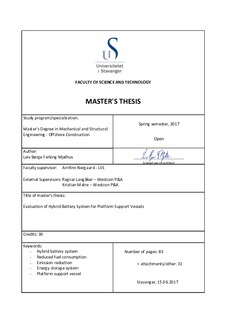| dc.contributor.advisor | Nergaard, Arnfinn | |
| dc.contributor.author | Mjølhus, Leiv Børge Ferking | |
| dc.date.accessioned | 2017-10-19T07:40:09Z | |
| dc.date.available | 2017-10-19T07:40:09Z | |
| dc.date.issued | 2017-07-15 | |
| dc.identifier.uri | http://hdl.handle.net/11250/2460942 | |
| dc.description | Master's thesis in Offshore structural engineering | nb_NO |
| dc.description.abstract | In the last few years, the car industry has developed hybrid battery systems with lower battery price, higher capacity and improved safety. These improvements in performance have led to an increased interest to utilize the technology in marine applications. To satisfy the requirements of redundancy in critical situations vessels are required to run multiple engines at low to medium loads during most of operations in station keeping. Traditional combustion engines are designed to have the optimal level of fuel consumption and lowest emission per kilowatt hour when operating at medium to high loads. This practice therefore represents an overall loss and is unfavorable for environment and fuel consumption.
This thesis investigates the effect and viability of applying a Hybrid Battery System (HBS) on a Platform Support Vessel (PSV) by using the battery to optimize the original power system. For the case study, the vessel Viking Energy has been considered. Viking Energy is the first vessel with a HBS approved as a redundant power source in critical operations. The system allows the vessel to reduce the numbers of active engines while ensuring instant available power if required. The remaining active engines are then operating closer to the optimal level, ensuring lower emission and fuel consumption per kilowatt hour. This study analyzes and quantifies the effect in fuel consumption and cost after implementing the HBS to the PSV. It also analyzes the weathers influence of the fuel consumption for the vessel with and without HBS. The study is based on a six-month sample period where the HBS was fully operative. The analysis gave an annual reduction in fuel of 13% comparing the sampling period with historical data given the same time distribution for the vessel. Normalizing both to actual distribution over a three-year operation period gives a calculated reduction of 17% due to more favorable distribution. The difference is mainly due to higher portion of Dynamic Positioning (DP) mode in the historical data. The economical evaluation concluded that the minimum threshold for overall fuel reduction to be 15% for the investment to break even in a ten-year perspective. A vessel is recommended to operate 34% or more of the time in DP or a mode providing similar level of fuel saving to meet an overall reduction of 15%. | nb_NO |
| dc.language.iso | eng | nb_NO |
| dc.publisher | University of Stavanger, Norway | nb_NO |
| dc.rights | Navngivelse 4.0 Internasjonal | * |
| dc.rights.uri | http://creativecommons.org/licenses/by/4.0/deed.no | * |
| dc.subject | offshore konstruksjoner | nb_NO |
| dc.subject | offshore construction | nb_NO |
| dc.subject | hybrid battery system | nb_NO |
| dc.title | Evaluation of Hybrid Battery System for Platform Support Vessels | nb_NO |
| dc.type | Master thesis | nb_NO |
| dc.subject.nsi | VDP::Technology: 500::Building technology: 530::Construction technology: 533 | nb_NO |
| dc.subject.nsi | VDP::Technology: 500::Marine technology: 580::Offshore technology: 581 | nb_NO |

